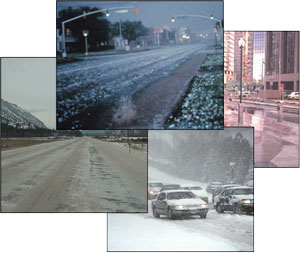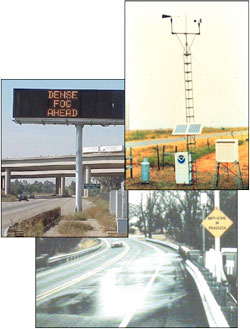Best Practices for Road Weather Management
Introduction

Weather threatens surface transportation nationwide and impacts roadway safety, mobility, and productivity. Weather affects roadway safety through increased crash risk, as well as exposure to weather-related hazards. Weather impacts roadway mobility by increasing travel time delay, reducing traffic volume throughput and speeds, increasing speed variance (i.e., a measure of speed uniformity), and decreasing roadway capacity (i.e., maximum rate at which vehicles can travel). Weather events influence productivity by disrupting access to road networks, and increasing road operating and maintenance costs.
 There is a perception that transportation managers can do little
about the average 7,130 fatalities and 629,000 injuries that occur
every year during adverse weather conditions. However, three
types of road weather management strategies may be employed in
response to environmental threats: advisory; control; and treatment
strategies. Advisory strategies provide information on
prevailing and predicted conditions to both transportation managers
and motorists. Control strategies alter the state of roadway
devices to permit or restrict traffic flow and regulate roadway
capacity. Treatment strategies supply resources to roadways to
minimize or eliminate weather impacts. Many treatment
strategies involve coordination of traffic, maintenance, and
emergency management agencies. These mitigation strategies are
employed in response to various weather threats including fog, high
winds, snow, rain, ice, flooding, tornadoes, hurricanes, and
avalanches.
There is a perception that transportation managers can do little
about the average 7,130 fatalities and 629,000 injuries that occur
every year during adverse weather conditions. However, three
types of road weather management strategies may be employed in
response to environmental threats: advisory; control; and treatment
strategies. Advisory strategies provide information on
prevailing and predicted conditions to both transportation managers
and motorists. Control strategies alter the state of roadway
devices to permit or restrict traffic flow and regulate roadway
capacity. Treatment strategies supply resources to roadways to
minimize or eliminate weather impacts. Many treatment
strategies involve coordination of traffic, maintenance, and
emergency management agencies. These mitigation strategies are
employed in response to various weather threats including fog, high
winds, snow, rain, ice, flooding, tornadoes, hurricanes, and
avalanches.
This report contains 27 case studies of systems in 22 states that improve roadway operations under inclement weather conditions. Each case study has six sections including a general description of the system, system components, operational procedures, resulting transportation outcomes, implementation issues, as well as contact information and references.
Version 2.0 presented 30 case studies from municipal and state transportation agencies. At this point, those solutions are either mainstreamed or have been surpassed by even better solutions. Version 3.0 captures the state-of-the-art, presenting 27 all-new practices that build upon these agencies’ previous successes.
previous | next